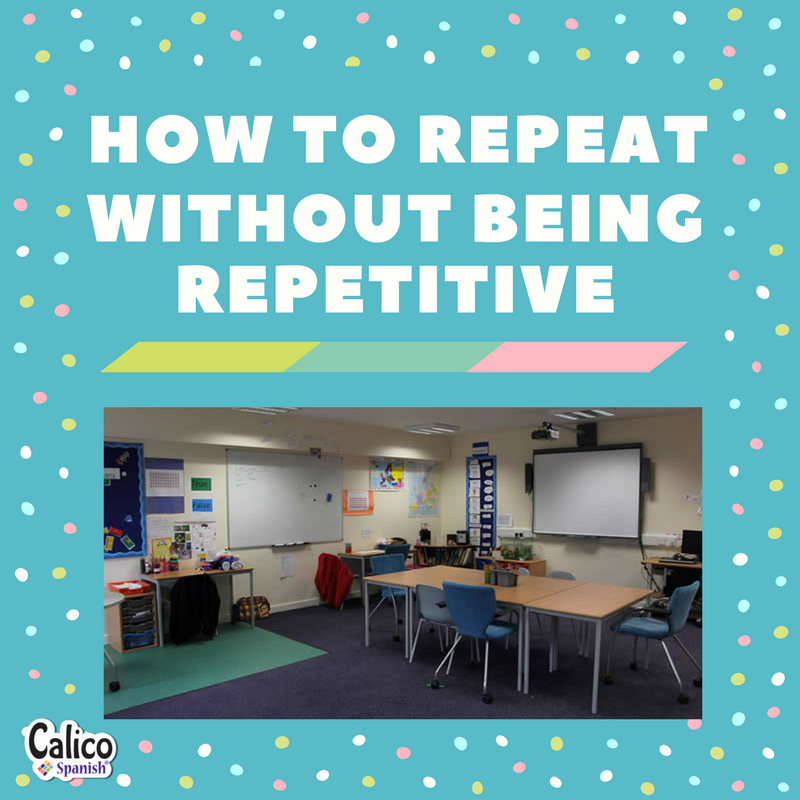7 ways to repeat without being repetitive
It feels like a catch-22, doesn’t it? Research shows that language learners need to hear or see a word in context many, many times in order to be able to use that word or phrase or language feature whenever they want. But wait- those learners also have to be engaged in order to acquire language. Bored learners aren’t learners at all. So, how do you repeat without being repetitive?
– Follow the blog on Bloglovin –
In the Calico Spanish Homeschool and Stories for Schools programs, we recommend you show the Video Story 10 times in 10 lesson days. But children will get bored with it, won’t they? Yes, they will– if you’re showing the same content the same way every time. But how do you keep repeating without being repetitive? Here are seven tips on how to keep children engaged in the same content even through several repetitions.
1. Use the flash cards.
The Stories programs don’t include flash cards so you can drill the fun out of Spanish. They’re part of the program so children can interact with the same content in a new way. Starting at the first time children will view a Video Story, hand out several of the flash cards, especially the ones that you are asked to feature in the first few lesson plans. Say the words together and ask children to listen carefully to hold theirs up when they hear it. Children will be excited to participate in this way (especially if they get to point out when a friend needs to hold up a card!).
2. Pause and ask.
As soon as children have seen the entire Video Story once, in later lessons pause the video at least once or twice to ask a question or otherwise ask children to interact with the visuals:
- “What is azul here?”
- “Let’s count the necklaces!”
- “Who can tell me their names? ¿Cómo se llama la mona?”
3. Give a challenge.
Every time children view the Video Story, announce a new challenge of something to listen for:
- “Today we’re going to listen for when María tells us how old she is! Who can jump when they hear her tell how old she is?”
- “Let’s count how many times we hear the word azul today! Hold up a finger every time you hear azul.”
- When we hear someone is bien, let’s say “¡Hurra!” and when we hear someone is mal, we’ll all say “Aw, ¡lo siento!”
- Who can answer the narrator’s questions before he gives us the answer?
– Like Calico Spanish on Facebook –
4. Change the order.
Don’t make watching the Video Story always be the first thing you do when you start your Spanish lesson. Consider these alternatives that can change up the order and create more variety in the routine:
- Start with a song video.
- Ask questions using a poster.
- Play “I spy.”
- Ask questions about the pictures in (or read together) the Storybook.
5. Take a break.
If you can tell children are not engaged with the video (and you will certainly be able to tell!), you all need a break.
- Show a Video Story up to a certain point, then stop the video and move on to other parts of the lesson plan.
- Skip the first vocabulary section.
- Pause the video and preview what’s coming next: “She’s about to tell us how she’s doing today. I want to find out! Can you help me hear it?”
- Use just the dialogue video.
- Pause at several questions and see if children can answer without the video’s help.
– Follow Calico Spanish on Twitter –
6. Ask for comprehension gestures.
Gestures are a great way for children to show they understand without the pressure of using Spanish words when they’re not ready. Ask them to give a particular gesture when they understand the target of the day.
- “Ready? We’re going to stretch our arms muy grande when we hear someone say grande!”
- “Let’s give a thumbs-up every time we hear the word bien!”
- “Stand up and let’s jump every time we hear someone mention saltar!”
7. Act it out.
As you move farther through the lesson plans towards the end of a Video Story’s Lesson, use the dialogue video and ask children to act out particular portions of it. Play a segment of the video; then, pause and ask children to reenact it. Remember full scripts of the videos are provided in the Activity Book.
What other creative ways have you thought of to help children engage with repeated content without it feeling boringly repetitive?







2 Comments
I love all your ideas and I’m already planning on using them with my Arabic 1-2 and French 1. Thanks a million times for sharing those strategies.
Great! Let us know if you come up with some more!